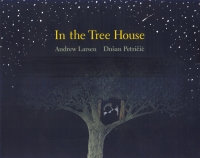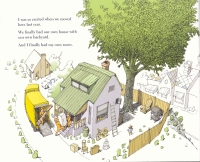| ________________
CM . . .
. Volume XIX Number 36. . . .May 17, 2013 
 |
In the Tree House.
Andrew Larson. Illustrated by Dušan Petricic.
Toronto, ON: Kids Can Press, 2013.
32 pp., hardcover, $18.95.
ISBN 978-1-55453-635-1.
Kindergarten-grade 4 / Ages 5-10.
Review by Gregory Bryan and Brittany Miller.
**** /4
|
| |
|

excerpt:
It’s hot. Really hot.
I crunch on an ice cube to cool off.
There’s more ice melting in the bowl beside me.
I can see the whole neighbourhood from up here.
It’s pretty nice.
There are lots of big, old trees.
But there’s only one tree house.
Kids Can Press’ new picture book, In the Tree House, is a heartwarming story involving a young boy struggling with the increasing gulf emerging between himself and his older brother. When they first moved with their parents to a new home, the boys were delighted to finally have a house with a backyard. Shortly thereafter, the boys were sharing the excitement and adventure of a tree house. One year later, however, the older brother has moved on to other things, and the story protagonist realizes the tree house is not nearly as much fun when he is the lone king of the castle.
 In the Tree House is told in the first person voice of the younger brother. It begins with him reminiscing about the previous summer when his family had finally moved into their new house and he no longer needed to share a bedroom. “I had trouble falling asleep at first,” the boy says. “I guess I missed sharing a room with my brother.” In the Tree House is told in the first person voice of the younger brother. It begins with him reminiscing about the previous summer when his family had finally moved into their new house and he no longer needed to share a bedroom. “I had trouble falling asleep at first,” the boy says. “I guess I missed sharing a room with my brother.”
Quickly, the boy becomes bored with a bedroom to himself. One night, to pass the time, he begins to create plans for tree houses. The boy, his father, and his sibling soon set to work building a tree house. The protagonist recalls those days shared with his brother in the tree house as “the best summer ever.” This following summer is not the same—the boy’s older brother does not want to spend time with his brother anymore. Things have all changed too quickly for the younger sibling.
My brother and I spent most of that summer in the tree house.
It was the best summer ever.
We had comics.
We had cards.
Dad even got us a couple of flashlights.
This summer has been different, though.
Very different.
My brother doesn’t spend any time in the tree house.
He hardly spends any time with me.
He’s too busy with his friends.
He says I’m too little to hang out with them.
He doesn’t even let me in his room anymore.
It is not until the power in the boys’ neighbourhood goes out that the brothers once again are together in the tree house.
Andrew Larsen’s text includes evocative word choices. For instance, on the page in which the blackout first occurs, we read that “the melting ice crackles in the bowl" while "something sparkles overhead” [emphasis added]. These word choices help the reader to feel as if a participant in the story. It is a story well-told and well-illustrated.
Dušan Petricic’s delightful illustrations are filled with action and detail. They were created with pen and ink and were coloured in Photoshop. The illustrator’s skillful use of colour, line and shading directs the reader’s attention to specific parts of each image. For instance, when the young boy says, “I was so excited when we moved here last year. We finally had our own house with our own backyard. And I finally had my own room”, the illustrations show a neighbourhood of houses with only the boy’s home and yard filled with colour, directing the reader’s eye to the house and emphasising the importance of the home to the young boy.
Petricic employs crosshatching to add details and shadows throughout the illustrations. This technique is especially fitting in communicating the shadows the city lights cast upon the neighbourhood during the night. The use of solid bright white backgrounds to represent the light of day, the delicate combination of light blues and yellows to reflect the glow of the city lights, and the pitch black to show the pure darkness of a blackout demonstrates the attention to detail the illustrator has taken to marry story and illustration. The stark contrast between the soft palette used for background information and the sparing use of darker and more vibrant colours is visually interesting and also works to draw the eye in certain directions. This visual interest is also augmented by the different size and placement of the text throughout the book.
Children and parents alike will find In the Tree House an enjoyable story to read and re-read. Children will be able to relate to the challenges that are part of growing up. They will also relate to the excitement and adventure of a tree house. Older readers will enjoy the nostalgic reverie evoked by the text. They will also relate to the tensions one feels in growing older as we embrace changes, yet simultaneously try to hang on to the past. Andrew Larsen and Dušan Petricic’s collaboration is superb. This is a book for young and for old.
Highly Recommended
Gregory Bryan is a member of the Faculty of Education at the University of Manitoba. Brittany Miller is a Bachelor of Education student at the University of Manitoba

To comment
on this title or this review, send mail to cm@umanitoba.ca.
Copyright © the Manitoba Library Association. Reproduction for personal
use is permitted only if this copyright notice is maintained. Any
other reproduction is prohibited without permission.
NEXT REVIEW |
TABLE OF CONTENTS FOR THIS ISSUE
- May 17, 2013.
AUTHORS |
TITLES |
MEDIA REVIEWS |
PROFILES |
BACK ISSUES |
SEARCH |
CMARCHIVE |
HOME |

 In the Tree House is told in the first person voice of the younger brother. It begins with him reminiscing about the previous summer when his family had finally moved into their new house and he no longer needed to share a bedroom. “I had trouble falling asleep at first,” the boy says. “I guess I missed sharing a room with my brother.”
In the Tree House is told in the first person voice of the younger brother. It begins with him reminiscing about the previous summer when his family had finally moved into their new house and he no longer needed to share a bedroom. “I had trouble falling asleep at first,” the boy says. “I guess I missed sharing a room with my brother.”